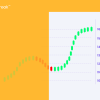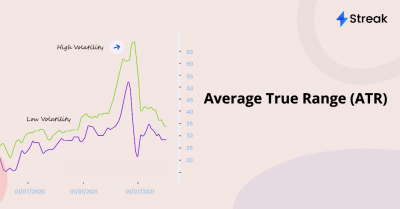If you’re a trend trader, you’re asking the market to ‘show its hand.’ In other words, you use the data available to you and use it to use advantage in determining the direction of the trend.
The Basics
It’s always good to get the basics out of the way so that we can jump to more interesting details. So, what is a trend? When the price is moving in one overall direction, such as up or down, that is called a trend. While Trend Trading, you follow the price closely and establish a trade when a particular trend takes place. In simple words, buy the stock if it is trending higher (uptrend) or sell if it is trending lower (downtrend). Also, it is made for all types of traders since it can be used on multiple time frames. Hence, it doesn’t matter if you are a day trader or a swing trader or you’re trading for longer time frames.
We now know that trading in the direction of the trend should be the first rule of Trend Trading. But we also need to determine the strength of the direction. You need to ask yourself the question of whether the trend is going to continue after you enter the trade. You don’t want to enter too late and see price reversal before you reach your target profit. You can use a technical indicator to determine this and take a position depending on the readings.
Why Trend Trading?
First things first. Trend Trading has stood the test of time. And that too for a good reason – it works! Documentation of trend trading dates back to the 19th and 20th centuries, and it continues to be popular to this day. One of the most famous trading experiments ever conducted, gathering a group of students with no trading experience in an attempt to turn them into successful traders (the “Turtle Traders”), was used with a trend following approach.
To understand why trend trading is effective, we need to understand the way the markets work. If you’re an active trader or you’ve started recently, you should know that the markets are based on an auction model of bids and asks and buyers and sellers. Therefore, logically, the big fish in the sea (the market participants with the big money — pension plans, mutual funds, banks, hedge funds, insurance companies, and other institutions) create the big moves in the market. Now, suppose one participant has big money and might be able to move the market by itself. And a group of them might have even more power. Trend trading helps you follow these market leaders and invest smartly.
Trading is becoming more and more complex. With indicators, tools, theories, and media & videos that you have at your fingertips, it might cause potential information overload. But Trend Trading is quite simple. It doesn’t require fancy knowledge about math or theories.
Pullbacks
Often known as a retracement, Pullback can be referred to as a temporary ‘pause’ in an existing trend. It usually occurs when there’s a large move in the direction of the trend. The price may retrace back to the median level after the large move. It keeps altering between a pullback and a strong trend. If the momentum of the trend is greater than the pullback, then it is a good bet because, despite the price pulling back, the long-term trend remains intact.
Breakouts
If the price has been ranging for some time, you can expect a sudden ‘breakout of the trend. The price might either rise or fall. But the trend is usually steep. Most of the time, it is not successful. They are short-lived and you can expect a trend reversal once the volumes are saturated. But during times when breakouts sustain, they can big winners. You need to be prepared for this.
Breakouts are different from Pullbacks. The frequency of a pullback is usually high and you can expect to make small wins instead of huge losses. You need to catch the price move from the ‘mean’ back to the top of the trending price. Whereas, in a pullback strategy, you need to catch the huge initial move.
The best trends arise after prices have been ranging for a while. Breakouts from a range occur when there is a disagreement between the buyers and sellers on price, which tips the balance of supply and demand. Whether it is more supply than demand or more demand than supply, it is the difference that creates price momentum.
Indicators that help Follow the Trend
- Moving Averages
The following conditions give a buy signal:
- when a shorter period moving average crosses above the longer period moving average
- when the more-sensitive moving moving average crosses above the less-sensitive moving average
- when price closes above the moving average
Moving Averages provide weak signals in ranging markets. That’s why you should club it with other technical analysis tools and indicators.
- RSI
Momentum indicators like the Relative Strength Index can be a great add-on to moving average. For example, you may wait for the RSI to drop below 30 and then rise above it. This could signal a long position, assuming the overall uptrend remains intact. The indicator is showing that the price pulled back but is now starting to rise again in alignment with the overall uptrend. Similarly, you can exit when the RSI falls below 70 or 80 levels.
- ADX
Breakouts are not hard to spot, but they often fail to progress or end up being a trap. However, ADX tells you when breakouts are valid by showing when ADX is strong enough for the price to trend after the breakout. When ADX rises from below 25 to above 25, the price is strong enough to continue in the direction of the breakout.
Conversely, it is often hard to see when price moves from trend to range conditions. ADX shows when the trend has weakened and is entering a period of range consolidation. Range conditions exist when ADX drops from above 25 to below 25. In a range, the trend is sideways, and there is a general price agreement between the buyers and sellers. ADX will meander sideways under 25 until the balance of supply and demand changes again.
Closing Thoughts
To conclude, trend following is a really important skill you should have. There are a lot of ways to follow price movements. Momentum indicators provide useful insights into uptrends and downtrends, overbought and oversold levels, and whether a trend is going to continue in a particular direction. You use a mix of Moving Averages, RSI, ADX, and other tools to determine your trading position.
Happy Trading!











